Birth rates in the developed world are below replacement levels and global fertility is not far behind. Sub-replacement fertility leads to exponentially decreasing population. Our best models of economic growth suggest that a shrinking population causes economic growth and technological progress to stop and humanity to stagnate into extinction.
One theory of fertility decline says it’s all about opportunity costs, especially for women. Rising labor productivity and expanded career opportunities for potential parents make each hour of their time and each forgone career path much more valuable. Higher income potential also makes it cheaper for parents to gain utility by using financial resources to improve their children’s quality of life compared to investing time in having more kids. Simultaneously, economic growth raises the returns to these financial investments in quality (e.g education).
In addition to higher incomes, people today have more diverse and exciting options for leisure. DINKs can go to Trader Joes and workout classes on the weekend, play video games, watch Netflix, and go on international vacations.
These rising opportunity costs accumulate into the large and pervasive declines in fertility that we see in the data.
If this explanation is correct, it puts a double bind on the case for economic growth. Unless AI upends the million-year old relationship between population and technological progress just in time, progress seems self defeating. The increases in labor productivity and leisure opportunities that make economic growth so important also siphon resources away from the future contributors to that growth. Empirically, the opportunity cost of having kids has grown large enough to bring fertility well below replacement levels all around the world. The opportunity cost explanation suggests we have to pick between high incomes and sustainable fertility.
Luckily, this explanation is not correct. At least not entirely. There are several observations that the opportunity cost theory cannot explain without clarification. Across and within countries today, the relationship between income and fertility is positive or U-shaped. Further economic growth can raise everyone’s incomes to the upward sloping part of the relationship and begin a 2nd demographic transition.
Micro Data
Above a $200k a year, fertility is increasing in household income.
** Update **
I replicated this graph from more recent ACS data (2018-2022) and also weighted each point by population to give a sense of the size of each of these income brackets
This U-shaped relationship holds up in multiple data sources with different measures of fertility. The households in the top percentiles of income stand to lose far more future wages from having children, but they have ~20 more children per hundred households than the middle income percentiles.
This isn’t exactly inconsistent with opportunity cost but it requires some explanation. The number of dollars that households are giving up by having children is increasing in household income, but as you get more and more dollars, each one is worth less. Going from making say $75 to $150 dollars an hour pushes you to work more hours, but if you go from $150 to $500, you might be happy to work half as many hours for more money and spend the time on other things, like starting a family. So while the dollar opportunity cost of having kids is always increasing in household income, the utility opportunity cost is not.
The positively sloped section of the relationship between income and fertility isn’t just spurious correlation either. Random shocks to wealth, like lottery winnings, also increase fertility.
This rules out the DINK leisure time explanation for low fertility too. High income households have access to the world’s best leisure opportunities, yet they still invest more time in child-rearing than lower income households. The time investment is even more upward sloping than the graph above shows because higher income parents spend more time on child care per-kid.
I think the explanation here is that childcare is a complement to many leisure activities rather than a substitute. Experiencing the joys and wonders of the world is better when you can experience them with and through your children.
It used to be that the wealthiest and highest educated women had the lowest fertility, but this trend is reversing.
Since this U-shaped relationship was not present in past data, it’s more likely that this effect is due to passing an absolute amount of income, rather than an effect of being in the top 1% of income whatever it may be. Economic growth can raise everyone’s incomes and push more people past this threshold on to the upward sloping part of the income-fertility curve.
Macro Data
This U-shaped pattern shows up in macro cross-country comparisons too. Earlier in the 20th century when most high-income countries were still going through their demographic transition, the relationship between GDP per capita and fertility was negative. The world was on the left side of the U-shaped curve. Today, all of these countries are much wealthier and the correlation is now positive: higher income countries also have higher fertility.
It used to be that countries with the highest female labor force participation had the lowest fertility rates, now it’s the opposite.
Across all countries today, there is a U-shaped relationship between fertility and GDP per capita.
Source: Ask GPT to combine this, this, and this
The correlation between fertility and GDP growth rates has also reversed, especially in high income countries.
Again we see evidence that getting past a threshold level of income or GDP per capita flips the sign on the relationship between income and fertility. The tradeoff between economic growth and high birthrates in long-term historical data and among currently developing countries is well established. But this negative relationship need not hold over all levels of income and indeed does not.
This reversal of the income-fertility relationship breaks the double bind that the opportunity cost theory seemed to place on progress.
Mechanism
What is causing the reversal of cross-country and within-country income-fertility relationships?
We’re finally hitting the downward sloping part of the labor supply curve. Time dedicated to labor is not forever increasing in labor productivity. Once you make enough money to comfortably provide for yourself and your family, many are happy to work less and raise more children. Economic growth can raise everyone’s income above this level. This is why Keynes predicted that the workweek would only be 15 hours long by 2030, and while we’re not quite there yet, working hours have been trending down for decades.
Fertility decline is multi-causal and overdetermined, so there are certainly other mechanisms driving both directions of the U-shaped fertility curve. Pro-natal culture is an important mechanism for fertility that I’ve ignored. Strict regulations and subsequent price rises for housing, childcare, and education are important contributors to fertility decline and can blunt or delay the U-shaped reversal.
The opportunity cost of raising children is clearly an important factor in parent’s fertility decisions and it is essential for modeling the industrial demographic transition. When economists were first studying this problem, income and fertility had a universally negative relationship. As incomes around the world have continued to increase, this negative relationship is beginning to break down. The women, men, and nations with the highest incomes and the most opportunities for leisure have higher fertility than the ones in the middle.
This is great news for progress. Rather than facing a tough tradeoff between high income and above-replacement fertility, we just need enough growth to get more people over the opportunity cost hump so that they’ll start having more kids as incomes increase.
This means that broad pro-growth policies like housing deregulation can raise birthrates even without specific subsidies for parents or childcare specific reforms, though the two will work better together. Falling fertility is one of the world’s most pressing challenges but we can grow our way out of it!

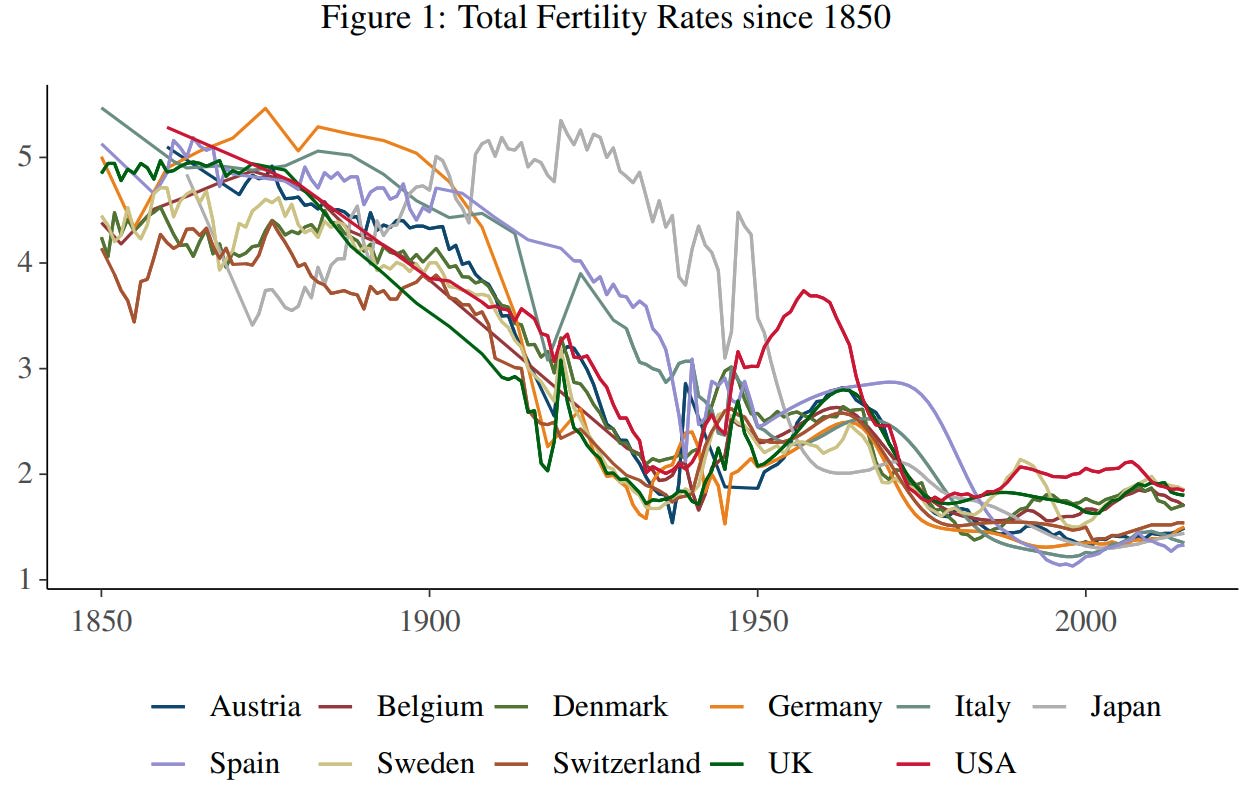
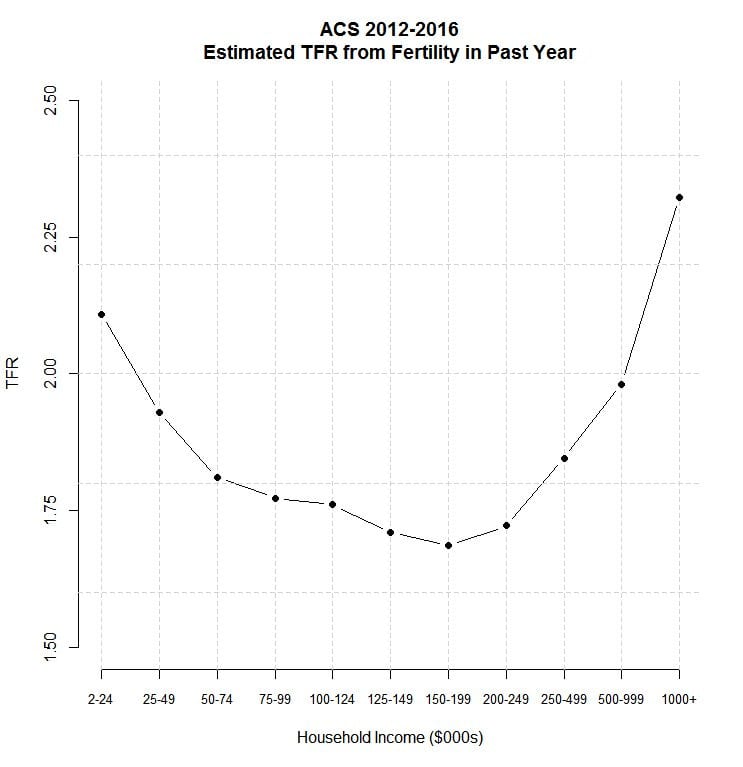
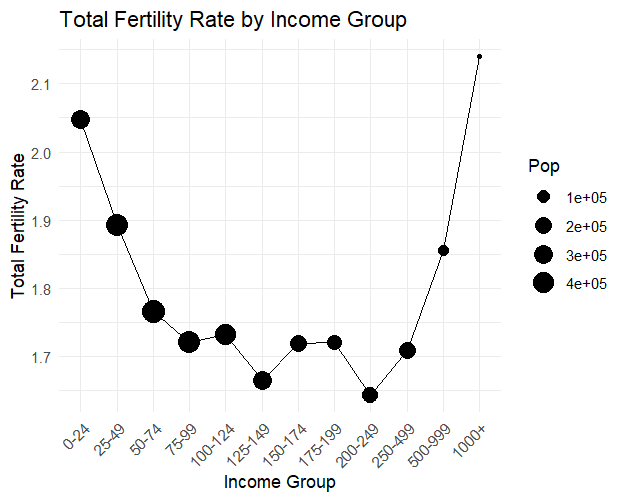
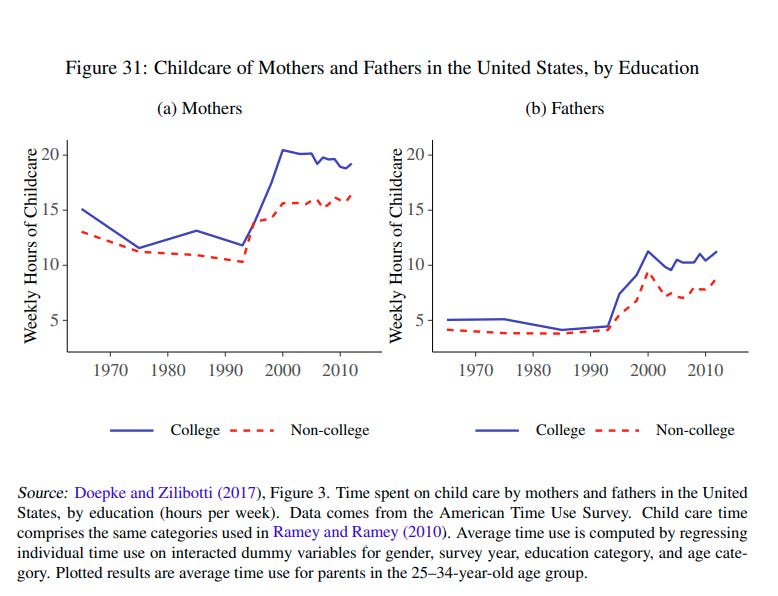
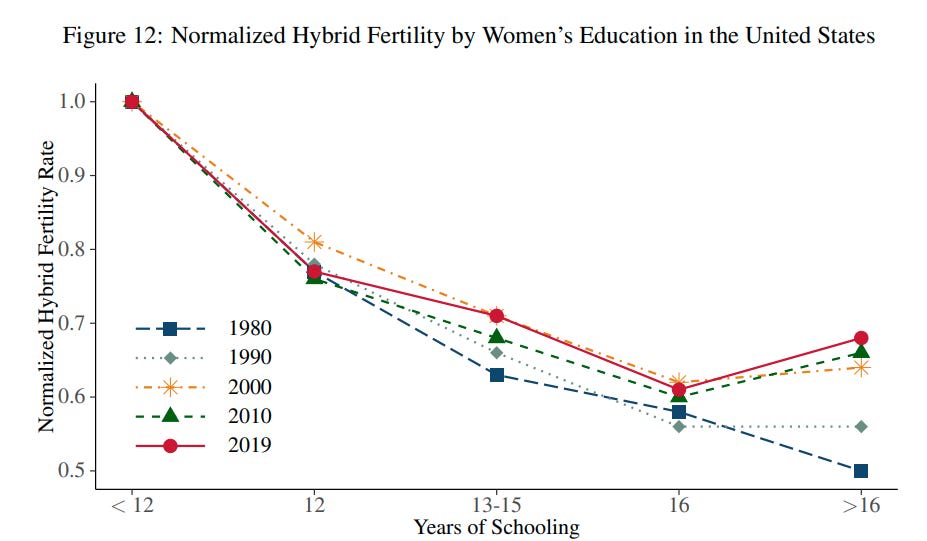
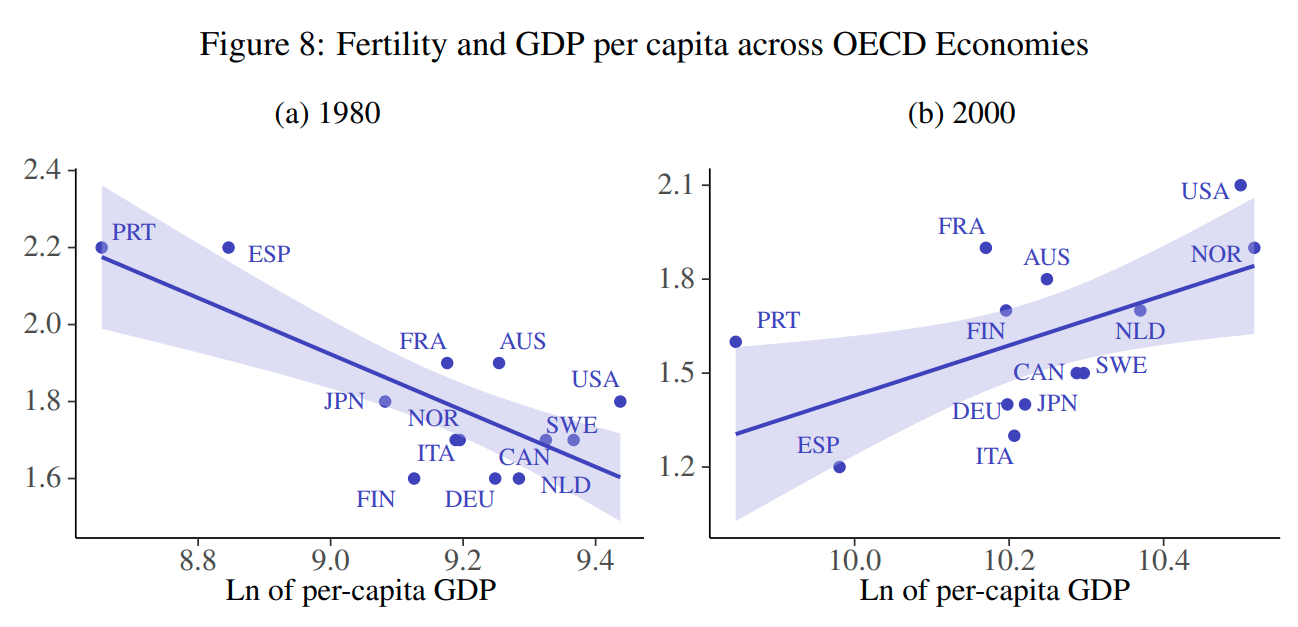
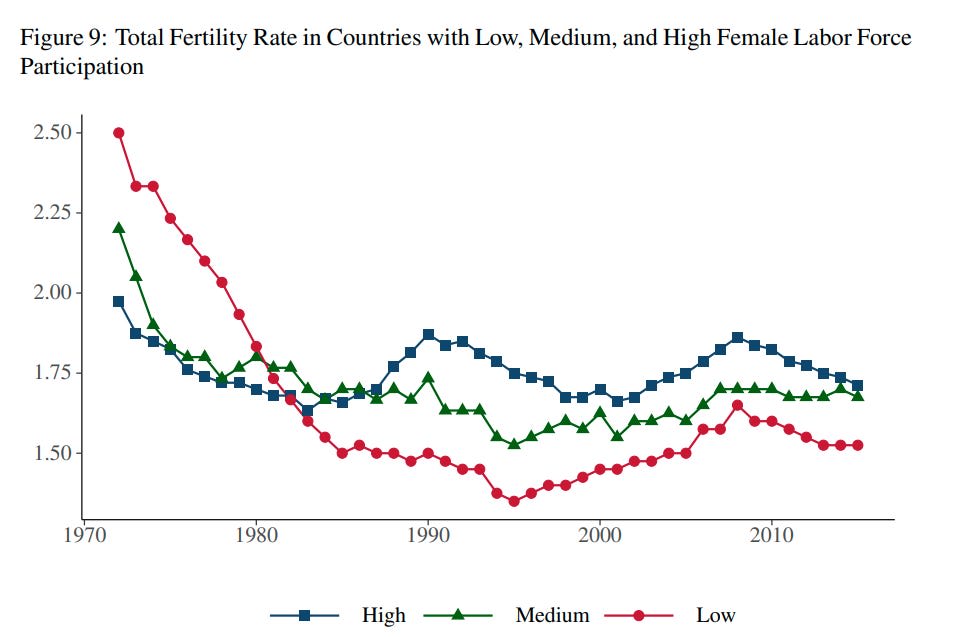
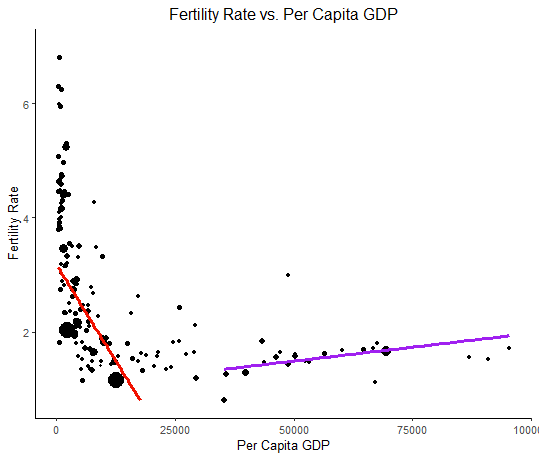
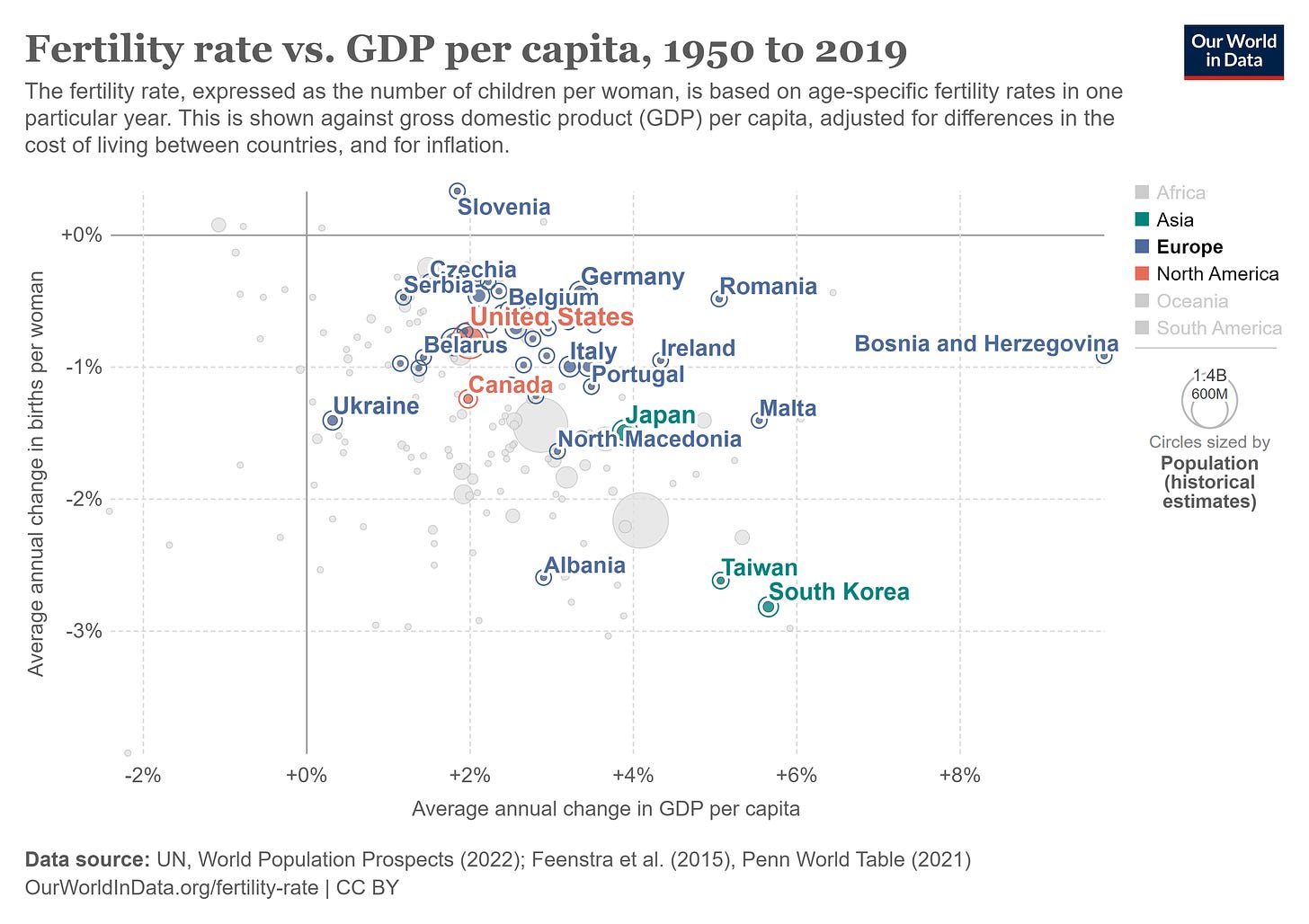
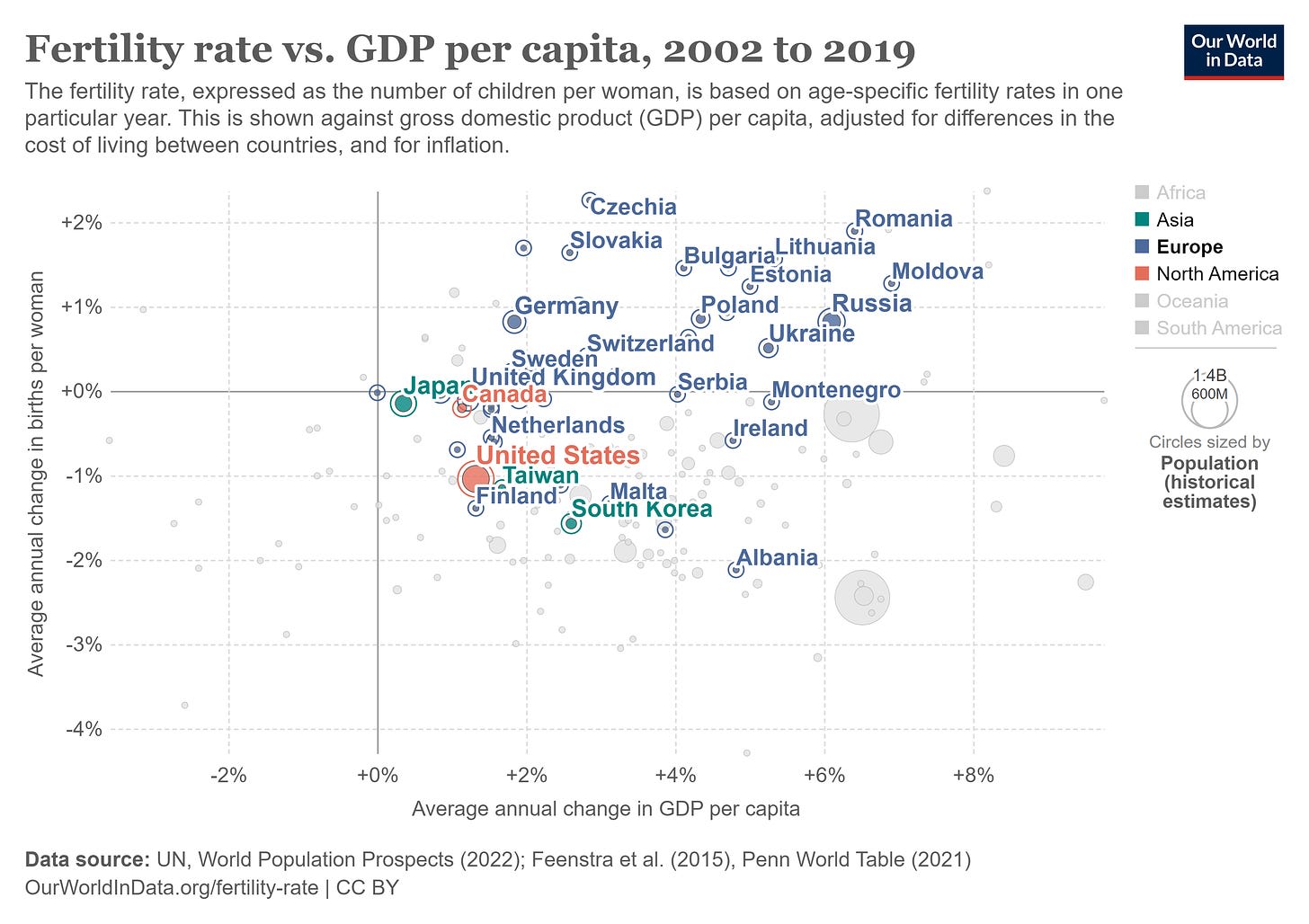
Executive summary: While rising opportunity costs from economic growth have driven fertility declines, recent data shows a U-shaped relationship between income and fertility, suggesting that further growth can reverse low birthrates and enable a sustainable future.
Key points:
This comment was auto-generated by the EA Forum Team. Feel free to point out issues with this summary by replying to the comment, and contact us if you have feedback.
People as paperclip maximisers (or bacteria in a petri dish)
Humans, the human species, operating unconsciously along the lines of their biological imperative - to reproduce, reproduce, reproduce - while providing so-called 'rational' justifications for that primitive imperative, like in this post, are essentially no different to Bostrom's paperclip maximiser: planetary resources and energy shovelled in at one end, humans (and their attendant domesticated animals and crops) popping endlessly out at the other, until nothing else is left. Our DNA is like that badly designed AI algorithm. Or, to use a different metaphor: we are no better than bacteria, multiplying explosively on their petri dish, until all the food is gone and they drown in the poisonous sea of their own excretions. So we need to consciously evolve to change this mindless imperative if we are to BOTH preserve the planet for future generations AND expand into the stars. (The two are not mutually exclusive.)
See here for some interesting ideas on human cultural evolution:
https://timwaring.info/2024/03/05/in-defense-of-octavia-butlers-earthseed-destiny/
and here for a more academic treatment:
https://royalsocietypublishing.org/doi/10.1098/rstb.2022.0259
This post appears to be blind to the dire state of the biosphere and the existential risks we are creating for our species by pushing beyond the planetary boundaries. Rather than seeing it as a challenge, we should be glad human fertility is falling. We are in the middle of the sixth mass extinction, sometimes referred to as the species holocaust. Laws are being passed to stop ecocide. Humanity and its domesticated animals and pets has exploded its ecological niche so massively that the biomass of wild animals, birds, insects etc. is only a fraction of ours. We are bloated beyond recognition, in ecological terms. We are totally out of balance with the rest of life on this planet.
For a movement that professes to be concerned about animal welfare, many EAs' ignorance about wild beings' suffering, the currently unfolding mass extinction, which translates to the wiping out of certain life forms forever until the end of time, is unfathomable to me.
IMHO, if you really do love animals, one of the best things you can do as an effective altruist is to refrain from having children.
See e.g.
(1)
https://overpopulation-project.com/reconciling-human-demands-with-planetary-boundaries/
"To sum up, possible combinations are:
Large population and high human development → then we cannot be ecologically sustainable and this situation cannot last.
Large population and ecological sustainability → then a large part of the population cannot achieve a high level of human development.
High human development and ecological sustainability → then population needs to diminish.
The fourth combination – large population, ecological sustainability and high human development – is not an option on a finite planet."
(2) The biomass distribution on Earth:
https://www.pnas.org/doi/full/10.1073/pnas.1711842115?doi=10.1073%2Fpnas.1711842115
(3) Leveraging deep change for a sustainable future in a world of overconsumption and overpopulation
https://www.researchgate.net/profile/Stephanie-Pettee-2/publication/358916338_Leveraging_Deep_Change_for_a_Sustainable_Future_in_a_World_of_Overconsumption_and_Overpopulation/links/621d7aa2579f1c0417224f1e/Leveraging-Deep-Change-for-a-Sustainable-Future-in-a-World-of-Overconsumption-and-Overpopulation.pdf
(4) Breaking boundaries but not population taboos
https://www.whp-journals.co.uk/JPS/article/download/759/516
(5) Against ecocide: legal protection for the Earth
https://www.greattransition.org/images/Against-Ecocide.pdf
(6)
Overpopulation is a major cause of biodiversity loss and smaller human populations are necessary to preserve what is left
Author links open overlay panelPhilip Cafaro a, Pernilla Hansson b, Frank Götmark b Show more Share Cite https://doi.org/10.1016/j.biocon.2022.109646 Get rights and content Highlights
• Global biodiversity decline is driven in large part by excessive human populations.
• Population decline opens up important opportunities for ecological restoration.
• Further research is needed into how human demographic changes help or hinder conservation efforts.
• Conservation biologists should advocate for smaller populations, in both less developed and more developed nations.
Abstract
Global biodiversity decline is best understood as too many people consuming and producing too much and displacing other species. Wild landscapes and seascapes are replaced with people, our domestics and commensals, our economic support systems, and our trash. Conservation biologists have documented many of the ways that human activity drives global biodiversity loss, but they generally neglect the role of overpopulation. We summarize the evidence for how excessive human numbers destroy and degrade habitats for other species, and how population decrease opens possibilities for ecological restoration. We discuss opportunities for further research into how human demographic changes help or hinder conservation efforts. Finally, we encourage conservation biologists to advocate for smaller populations, through improved access to modern contraception and explicit promotion of small families. In the long term, smaller human populations are necessary to preserve biodiversity in both less developed and more developed parts of the world. Whether the goal is to save threatened species, create more protected areas, restore degraded landscapes, limit climate disruption, or any of the other objectives key to preserving biodiversity, reducing the size of the human population is necessary to achieve it.
https://www.soltechdesigns.com/sustainable/Overpopulation-and-biodiversty-loss(2022).pdf
Hi Deborah, I also disagree with this comment (and have disagree voted but not downvoted it). Here are some of my reasons:
I also think it is unfair to call the post 'utterly blind to the dire state of the biosphere and the existential risks we are creating for our species by pushing beyond the planetary boundaries'. Rather I think these concerns are outside the scope of this post.
Hi Siao Si, thanks for your detailed response. I'll try to address some of your points, though not in the order you state them.
Firstly, it is necessary to treat the issues of carrying capacity and optimum human population differently; they are not the same. It is also incorrect to say that many agree that 10 billion is the carrying capacity. The estimate of how many humans earth can support is in flux: on the one hand, technological developments e.g. to improve distribution of resources could extend carrying capacity; on the other hand, the accelerating ecological degradation of the planet (including but not solely due to the climate crisis) is resulting in a shrinkage of the land area able to support crop production and we are currently on a trajectory of collapse in ocean fisheries due to unsustainable fishing practices.
Secondly, there is huge variation in experts' estimates of the optimum human population, enabling abundance and flourishing for all - some go as low as only 100,000 humans.
See here for different scenarios:
https://populationmatters.org/news/2023/05/sustainable-population-the-earth4all-approach/
Noting that I disagree with this comment so I’ve disagree voted. But I don’t think this means I should necessarily downvote it as well, which is what people seem to be doing. But please correct me if I’m wrong!
I sometimes downvote comments and posts mostly because I think they have "too much" karma - comments and posts I might upvote or not vote on if they had less karma. As I look at the comment now it has 2 karma with 11 votes - maybe at some point it had more and people voted it back to 2?
I would have downvoted this comment if it had more karma because I think Deborah's comment can be read as antagonistic: "utterly blind", "dire state", "for heaven's sake!", calling people ignorant. In this context I didn't read it this way, but I often vote based on "what would the forum be like if all comments were more like this" rather than "what intentions do I think this person has".
Thank you for your feedback, text has been revised.
It has 0 net karma on 12 votes, 1 agree vs 8 disagree. So it's very likely that it has some users pairing disagree votes with upvotes. I appreciate people being willing to upvote stuff that deserves it despite their disagreement.
Downvotes are more likely for tone than anything else. "This post is utterly blind" will almost always draw a downvote from me.
Thanks for your feedback, text has been revised.
Please provide arguments for your disagreement if possible James. Thank you :-).
Would love to but didn't feel best placed/didn't have time. Just wanted to encourage people to disagree vote instead of downvote, or at least explain why they're downvoting.
If you are right for a while we have the recipe for population stabilization. Too good to be true!
In the long run, of course, Darwin always bring back Malthus.